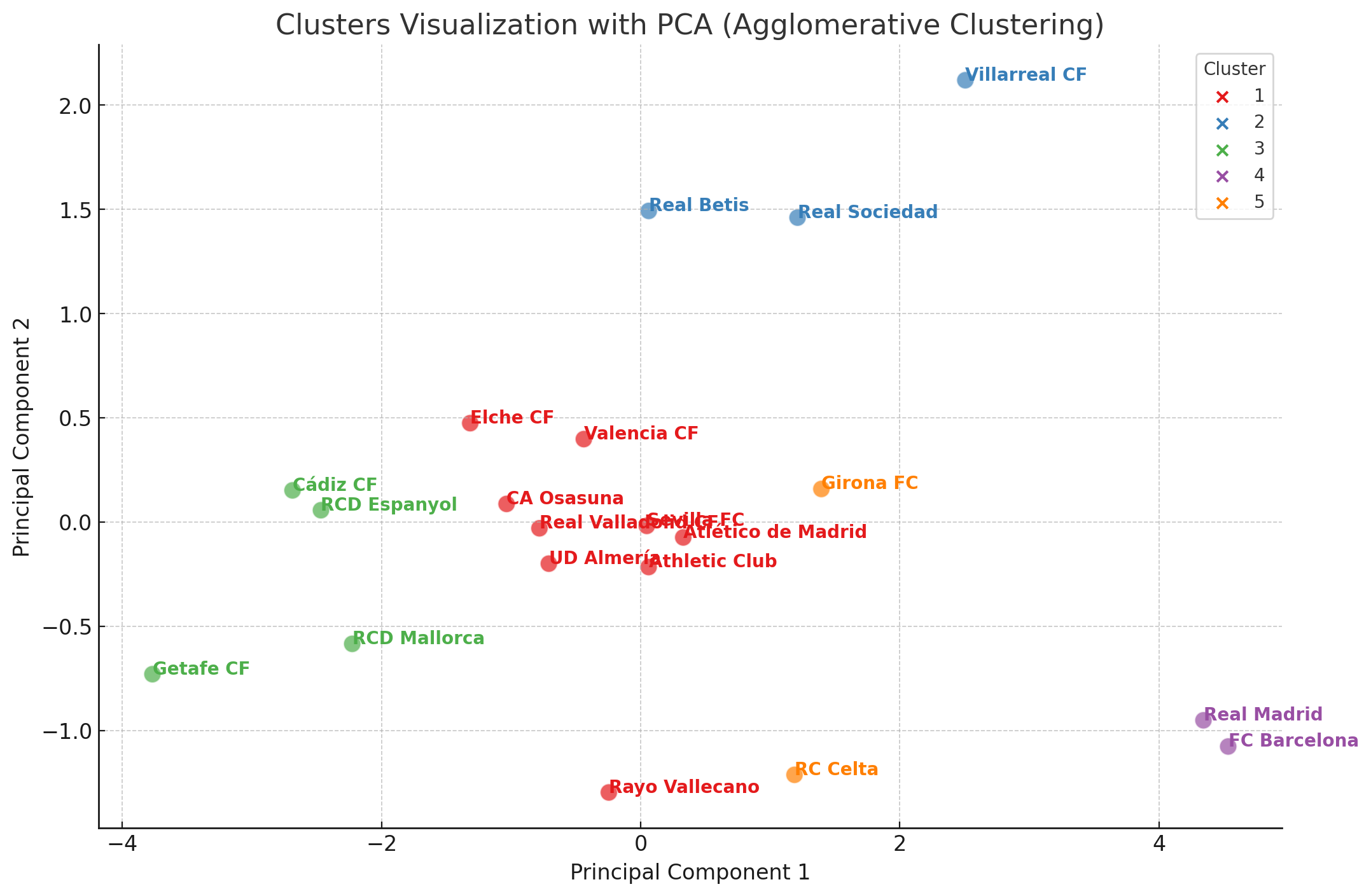
02 Ago Innovation in Classifying Offensive Playing Styles in LaLiga: A Ball-Tracking-Based Approach

Abstract:
This study presents a novel methodology for classifying the offensive playing styles of teams in LaLiga during the 2022/23 season using ball-tracking data. Unlike traditional approaches that rely on metrics such as possession and game events, our analysis focuses exclusively on metrics derived from ball movement. We employed advanced clustering techniques to identify natural groupings among teams, offering a fresh perspective for coaches and analysts.
Introduction:
In modern football, understanding the offensive playing styles of teams is crucial for developing effective strategies. Traditionally, analyses have relied on metrics such as possession percentage, the number of passes, and the speed of ball circulation. However, with the availability of high-quality ball-tracking data provided by LaLiga through optical tracking cameras, a new opportunity arises to analyze offensive playing styles based solely on ball movement.
Methodology:
Metric Selection:
For this study, we selected the following ball-tracking metrics, focusing on the offensive phase, specifically from the 2022/23 season:
- Total ball distance (m): The total distance covered by the ball during the match.
- Aerial ball distance (m): The total distance the ball traveled in the air during the match, indicating the use of long passes.
- Ball distance in own half (m): The total distance covered by the ball in the team’s own half.
- Ball distance in opponent’s half (m): The total distance covered by the ball in the opponent’s half.
- Average ball speed (km/h): The average speed at which the ball moved during the match.
- Ball time in play (min): The total time the ball was in play, expressed in minutes.
Data Normalization:
To ensure that all metrics had the same influence on the analysis, we normalized the data. This allowed each metric to contribute equally to the clustering process.
Clustering Techniques:
We applied agglomerative hierarchical clustering to identify natural groupings among the teams. This technique does not require specifying the number of clusters in advance and allows visualizing the hierarchical relationships between teams through a dendrogram.
Results:
The analysis revealed five distinctive clusters among LaLiga teams, focusing on their offensive playing styles during the 2022/23 season:
Cluster 1:
- Teams: Athletic Club, Atlético de Madrid, CA Osasuna, Elche CF, Rayo Vallecano, Real Valladolid CF, Sevilla FC, UD Almería
- Description:
- Total ball distance: Medium
- Aerial ball distance: Medium
- Ball distance in own half: High
- Ball distance in opponent’s half: Medium
- Average ball speed: High
- Ball time in play: Medium
Cluster 2:
- Teams: Real Betis, Real Sociedad, Villarreal CF
- Description:
- Total ball distance: High
- Aerial ball distance: Low
- Ball distance in own half: Low
- Ball distance in opponent’s half: High
- Average ball speed: Medium
- Ball time in play: High
Cluster 3:
- Teams: Cádiz CF, Getafe CF, RCD Espanyol, RCD Mallorca
- Description:
- Total ball distance: Low
- Aerial ball distance: High
- Ball distance in own half: High
- Ball distance in opponent’s half: Low
- Average ball speed: Medium
- Ball time in play: Low
Cluster 4:
- Teams: FC Barcelona, Real Madrid
- Description:
- Total ball distance: High
- Aerial ball distance: Low
- Ball distance in own half: Low
- Ball distance in opponent’s half: High
- Average ball speed: High
- Ball time in play: High
Cluster 5:
- Teams: Girona FC, RC Celta
- Description:
- Total ball distance: Medium
- Aerial ball distance: Medium
- Ball distance in own half: Medium
- Ball distance in opponent’s half: Medium
- Average ball speed: Medium
- Ball time in play: Medium
Discussion:
Utilizing ball-tracking data to classify offensive playing styles provides an innovative and more precise view of team strategies. The results show that this methodology can identify patterns that traditional approaches might overlook. For coaches, this offers a valuable tool for analyzing both their teams and their opponents, enabling more detailed and specific tactical preparation.
It is important to note that this model focuses exclusively on the offensive phase of the game, as it is based on ball-related metrics.
Limitations:
Given that this study intentionally focused on ball-tracking metrics to analyze offensive playing styles, some nuances might be missed, or certain teams might be grouped unconventionally. This approach does not consider defensive aspects or other traditional eventing metrics. Therefore, a combined model that includes both ball-tracking metrics and traditional eventing metrics could offer a more comprehensive and accurate classification of playing styles.
Conclusion:
This study introduces a novel methodology for classifying offensive playing styles in football, using exclusively ball-tracking data from the 2022/23 season. The results highlight the ability of this technique to identify significant groupings among LaLiga teams, providing a new perspective for coaches and analysts. Adopting this approach can lead to a deeper understanding of playing strategies and improvements in tactical preparation.


